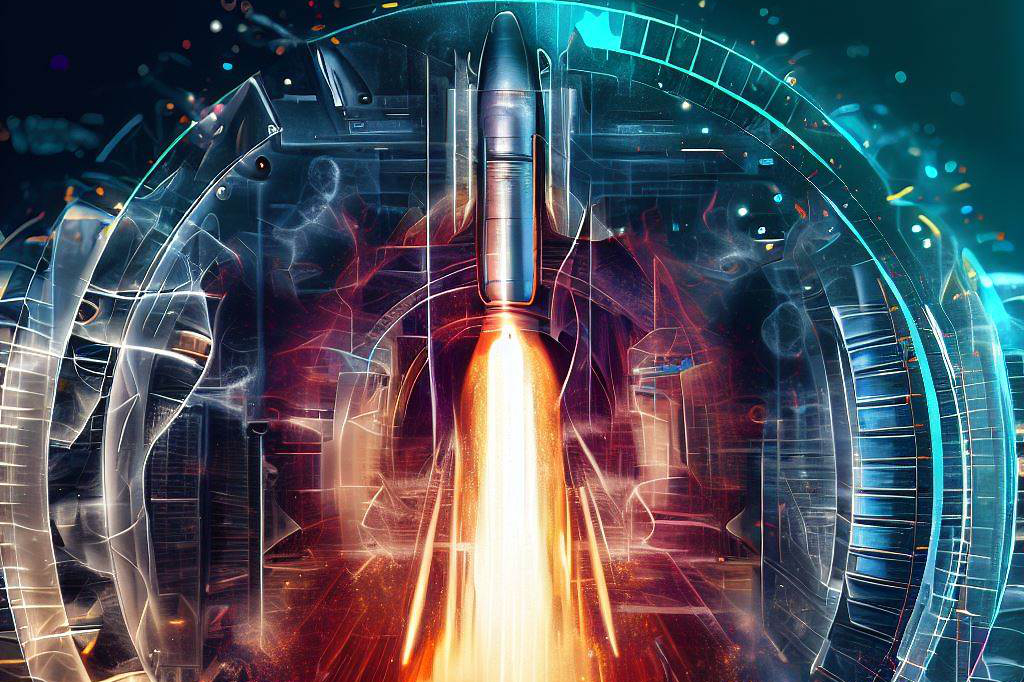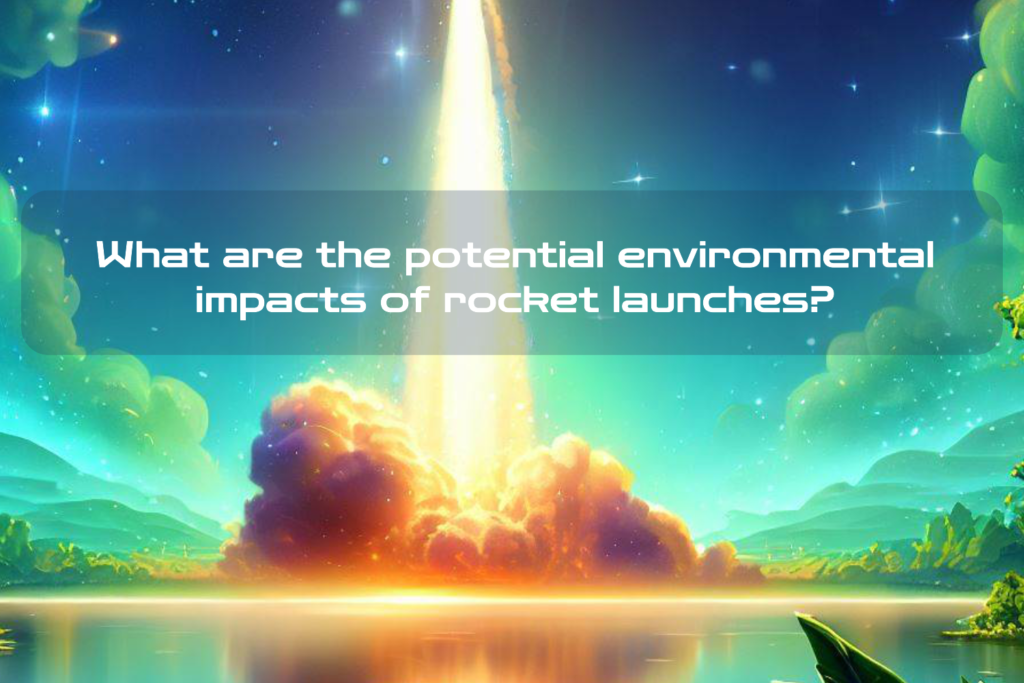Ascending Ambitions: Exploring the Ecological Ripples of Rocket Launches
Rocket launches have long been a symbol of humanity’s ambition to explore the vast reaches of space. These awe-inspiring events captivate our imagination, representing the pinnacle of technological achievement and human ingenuity. However, as we embark on this journey to the stars, it becomes crucial to understand and address the potential environmental impacts associated with rocket launches.
Definition of Rocket Launches
Rocket launches refer to the process of propelling a spacecraft or satellite into space using powerful propulsion systems. This intricate procedure involves igniting rocket engines, which generate an immense amount of thrust to overcome Earth’s gravitational pull and achieve escape velocity. Rockets can be categorized into various types, including expendable rockets that are discarded after a single use and reusable rockets designed to return safely to Earth for multiple missions.
Growing Interest in Space Exploration and its Impact on the Environment

In recent years, there has been an exponential surge in global interest in space exploration. Governments, private corporations, and scientific organizations alike are investing heavily in research and development projects aimed at unlocking the mysteries of our universe.
As this enthusiasm for space travel intensifies, so does its potential impact on the environment. The quest for space exploration entails numerous activities that can significantly influence our planet’s delicate ecosystems.
From manufacturing rocket components using energy-intensive processes to launching massive vehicles that consume vast quantities of fuel within seconds, each stage contributes its share towards environmental implications. Moreover, with an ever-increasing number of rocket launches taking place worldwide at various locations, understanding these ecological consequences becomes paramount.
While it is essential not to dampen our collective fascination with space exploration and discovery, it is crucial that we approach these endeavors responsibly and take proactive measures to mitigate their environmental effects. By exploring alternative propellants or adopting greener technologies throughout the aerospace industry’s supply chain, we can strike a balance between our innate desire to explore the cosmos and our responsibility as custodians of Earth’s fragile environment.
Only by doing so can we ensure that our journey to the stars leaves a positive, lasting legacy for future generations.
Overview of Rocket Launches

The Significance of Rocket Launches for Space Exploration and Satellite Deployment
Rocket launches play a pivotal role in space exploration and the deployment of satellites, making them a cornerstone of modern scientific advancements. These launches are crucial for various purposes, including the
- exploration of celestial bodies,
- the study of space phenomena,
- and the establishment of communication networks through satellite constellations.
The ability to venture beyond Earth’s atmosphere allows scientists to conduct research that deepens our understanding of the universe and facilitates technological developments that benefit humanity as a whole. Moreover, rocket launches enable the deployment of satellites into orbit.
Satellites serve an array of essential functions, such as
- weather forecasting,
- navigation systems (GPS),
- telecommunications,
- Earth observation for climate monitoring and disaster management,
as well as supporting scientific research in areas like astronomy or environmental studies. These orbiting devices provide invaluable data that aids in crucial decision-making processes across multiple industries, from agriculture to finance.
Types of Rockets Used for Launches (e.g., Expendable, Reusable)
Modern rocket launches encompass two primary categories: expendable rockets and reusable rockets.
Expendable rockets are designed for one-time use; they are launched into space and are unable to return intact to Earth’s surface. This type typically includes vehicles like SpaceX’s Falcon 9 or United Launch Alliance’s Atlas V. The advantage lies in their cost-effectiveness since they do not require extensive refurbishment before each launch.
However, their single-use nature contributes significantly to space debris accumulation.
In contrast, reusable rockets aim to reduce costs by enabling multiple launches with minimal refurbishment between missions.
Examples include SpaceX’s Falcon Heavy and Blue Origin’s New Shepard rockets. This sustainable approach reduces both the economic expenses associated with manufacturing new rockets for each mission and the environmental impact stemming from discarded rocket parts left in orbit or on Earth after launch.
Frequency and Locations of Rocket Launches Worldwide
Rocket launches occur globally, with various countries and private companies participating in this awe-inspiring endeavor. The frequency of launches has increased considerably in recent years due to advancements in technology, commercial interests, and the growing accessibility of space exploration.
Leading the pack, the United States, Russia (formerly the USSR), and China have historically conducted numerous missions.
However, private entities such as SpaceX and Blue Origin have emerged as significant players in the global space industry. Launch sites are strategically located to maximize safety and efficiency while minimizing risks to populated areas.
Some notable locations include
- Cape Canaveral Space Force Station (Florida, USA),
- Baikonur Cosmodrome (Kazakhstan),
- Kennedy Space Center (Florida, USA),
- Jiuquan Satellite Launch Center (China),
- Vandenberg Space Force Base (California, USA),
along with several others worldwide. These launch sites accommodate various types of rockets and provide unique advantages depending on factors such as orbital inclination requirements or proximity to the equator for energy-efficient launches.
Air Pollution from Rocket Launches

Emissions during rocket propellant combustion
Rocket launches, while propelling us into the realms of space exploration, are not without their environmental consequences. One significant concern is the emission of pollutants during the combustion of rocket propellants. This process releases a cocktail of gases into the atmosphere, contributing to air pollution on various fronts.
Release of greenhouse gases (carbon dioxide, water vapor)
One primary concern stemming from rocket launches is the release of greenhouse gases such as carbon dioxide (CO2) and water vapor (H2O). The combustion of rocket propellants produces vast quantities of CO2, a potent greenhouse gas known for its role in global warming. Additionally, water vapor is also emitted in substantial amounts during launches.
Although H2O itself is not a direct contributor to climate change like CO2, it plays a role in amplifying atmospheric warming through its positive feedback effect. These emissions from rocket launches contribute to the overall anthropogenic footprint on our planet’s climate system.
The cumulative effect becomes significant as space agencies conduct more frequent missions and launch larger rockets capable of carrying heavier payloads. Consequently, it becomes imperative for space organizations to explore greener and more sustainable alternatives for propulsion systems to mitigate these emissions and reduce their impact on global climate patterns.
Production of nitrogen oxides contributing to smog formation
In addition to greenhouse gases, rocket launches also result in the production of nitrogen oxides (NOx), which contribute to smog formation. The high temperatures generated during rocket propulsion cause atmospheric nitrogen and oxygen molecules to react, forming NOx compounds such as nitric oxide (NO) and nitrogen dioxide (NO2). These pollutants participate in complex chemical reactions with other substances present in the atmosphere, eventually leading to smog formation.
The release of NOx into the atmosphere by rocket launches adds yet another layer to the ongoing battle against air pollution in our communities. With the increasing number of launches worldwide, particularly in regions with heavy launch activity, it becomes crucial for regulatory bodies and space organizations to develop and implement stringent emission control measures to minimize the impact of these pollutants on air quality.
Impact on stratospheric ozone layer depletion due to chlorine compounds in propellants
An often-overlooked environmental concern related to rocket launches is their potential contribution to stratospheric ozone layer depletion. Some rocket propellants, particularly those involving hypergolic fuels such as hydrazine, contain chlorine-based compounds. When released into the atmosphere, these compounds can react with ozone molecules in the stratosphere, resulting in their destruction.
The stratospheric ozone layer plays a critical role in shielding life on Earth from harmful ultraviolet (UV) radiation emitted by the Sun. Any significant reduction in its thickness could have detrimental consequences for both human health and ecosystems.
Therefore, it is essential for space agencies to carefully consider alternative propellant options that do not contain substances known for their adverse effects on atmospheric ozone concentrations. While rocket launches enable remarkable advancements in space exploration and satellite deployment, they are not without environmental repercussions.
Water Pollution from Rocket Launches

Contamination from rocket fuel residue and debris falling into oceans or bodies of water near launch sites
Rocket launches, although awe-inspiring events, have the potential to contribute to water pollution due to the contamination caused by rocket fuel residue and debris. During lift-off and ascent, rockets shed various components that may eventually find their way into nearby bodies of water, such as oceans or lakes.
These components include discarded stages, fairings, and residual propellants expelled during separation maneuvers. The presence of these materials introduces pollutants into aquatic environments, posing a threat to overall water quality.
Debris falling into bodies of water can lead to a cascade of negative environmental consequences. For instance, fragments of discarded rocket stages may contain hazardous substances like heavy metals or other toxic chemicals used in manufacturing processes or propellants.
When this debris sinks or disintegrates in the water column, there is a risk that these contaminants will become absorbed by marine organisms through ingestion or accumulation in their tissues. Over time, this can impair the health and reproductive capabilities of marine life.
Toxicity issues associated with hypergolic propellants (e.g., hydrazine)
Hypergolic propellants used in specific rocket engines pose an additional concern for water pollution during rocket launches.
One notable example is hydrazine—a highly toxic compound commonly employed as a propellant component due to its hypergolic nature (ability to ignite spontaneously upon contact with an oxidizer).
In the event of an unsuccessful launch or a mishap during fueling/loading operations, there is a risk that residual hydrazine can contaminate nearby bodies of water. Hydrazine is exceptionally toxic, even at low concentrations, and poses significant risks for both terrestrial and aquatic ecosystems alike.
Its introduction into water sources can result in acute toxicity for aquatic organisms, causing severe damage to their organs and impairing their overall survival. Furthermore, as hydrazine is highly soluble in water, it can quickly disperse and contaminate larger volumes of water, exacerbating the potential harm to marine life.
Potential harm to marine life and ecosystems
The contamination resulting from rocket launches has the potential to cause substantial harm to marine life and fragile ecosystems. Aquatic organisms are particularly vulnerable due to their direct exposure to pollutants released during launch events.
The residual rocket fuel compounds and debris can directly affect the physiology, behavior, and reproductive processes of various marine species.
Additionally, rocket launches generate intense noise levels that can have detrimental effects on aquatic creatures.
Marine animals rely heavily on acoustic communication for mating, foraging, and navigation purposes. The loud noises produced during liftoffs and supersonic flight phases may disrupt these vital activities for marine organisms, leading to disorientation or even permanent hearing loss.
To protect marine life from these potential harms, it is essential for space agencies and launch operators to implement stringent environmental management protocols. These measures should include strategies for debris retrieval from bodies of water near launch sites, the safe disposal of toxic propellant residues without contaminating aquatic environments further, and minimizing noise pollution through mitigation techniques during rocket launches.
Noise Pollution from Rocket Launches

The Earth Shakes and Eardrums Tremble: Intense Noise Generated during Liftoff and Supersonic Flight Phases
Rocket launches are not only a breathtaking spectacle for spectators; they also unleash an awe-inspiring symphony of sound. The liftoff phase, marked by the ignition of the rocket’s engines, generates a thunderous roar that reverberates across the launch site and beyond.
As the rocket ascends into the sky, it transitions to supersonic speeds, producing shockwaves that break through the sound barrier with resounding booms. These sonic booms can be heard for miles around, leaving no doubt about the immense power harnessed by these technological marvels.
A Deafening Disruption: Effects on Wildlife, Particularly
The intense noise generated during liftoff and supersonic flight phases can have detrimental effects on wildlife populations in close proximity to launch sites.
Birds nesting nearby may be startled by sudden loud noises, leading to disorientation or even abandoning their nests altogether. Marine life is also vulnerable to noise pollution caused by rocket launches conducted near bodies of water.
Underwater species such as dolphins and whales rely heavily on sound for communication and navigation purposes. The explosive sounds produced during rocket takeoffs can disrupt their feeding patterns or cause physical harm due to pressure changes in water columns.
Final Thoughts

As humanity continues its quest to explore the wonders of space, it is crucial that we remain cognizant of the potential environmental impacts associated with rocket launches. While noise pollution poses challenges for terrestrial and marine ecosystems alike, advancements are being made to mitigate these effects through careful site selection and engineering improvements.
By investing in research and development, scientists and engineers are devising quieter propulsion systems and launch technologies that minimize noise pollution without compromising the mission’s objectives. Furthermore, international regulations and collaborative efforts among space agencies are seeking to strike a balance between space exploration and environmental conservation.
In this era of rapid technological progress, let us reaffirm our commitment to responsible practices that consider the preservation of our planet’s delicate ecosystems. While the potential environmental impacts of rocket launches cannot be ignored, by addressing these challenges head-on with innovation and foresight, we can pave the way for a future where humanity peacefully coexists with nature while reaching for the stars.

C M, a seasoned editor, journalist, and consultant, is deeply fascinated by the convergence of technology, space, and the future of humanity.
With a particular interest in transhumanity, futurology, and the philosophical and ethical dimensions of these domains, C M serves as the lead contributor to SpaceSpotlight and TranscendSphere.
When not penning insightful articles on these rapidly evolving fields, C M indulges in their love for podcasts and books, proudly embracing their status as a ‘Happy Nerd Extraordinaire!’



